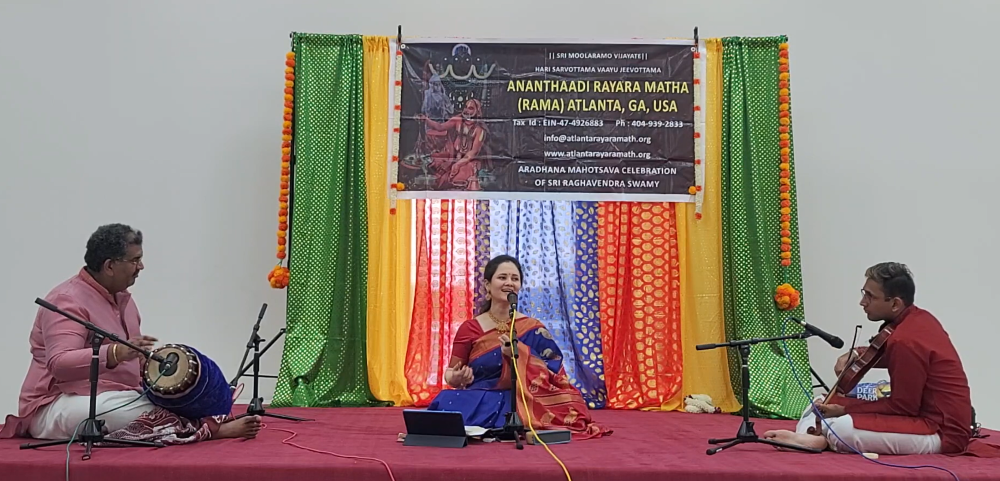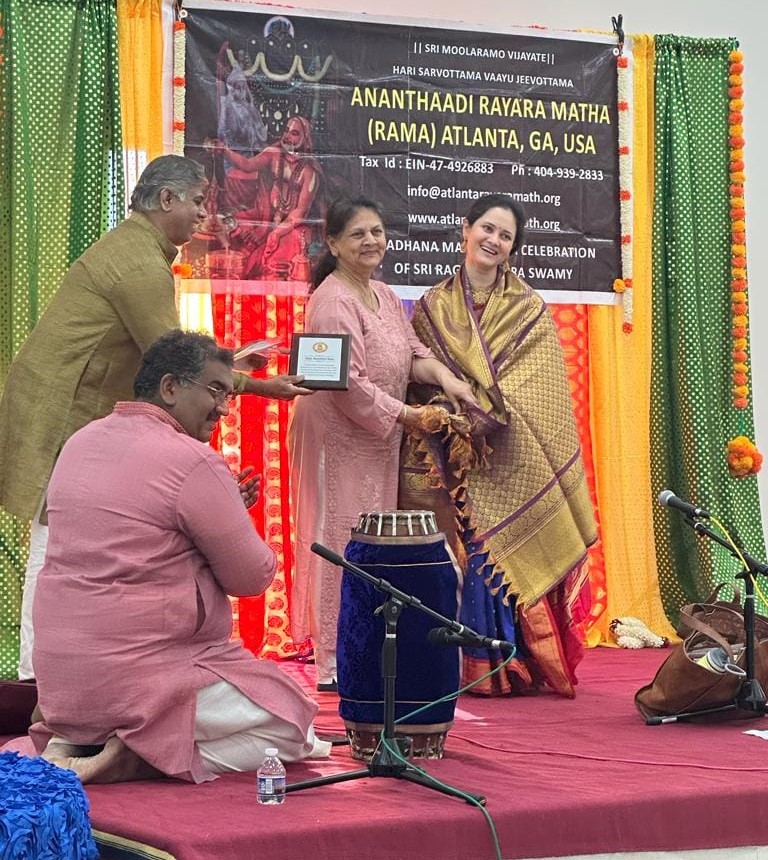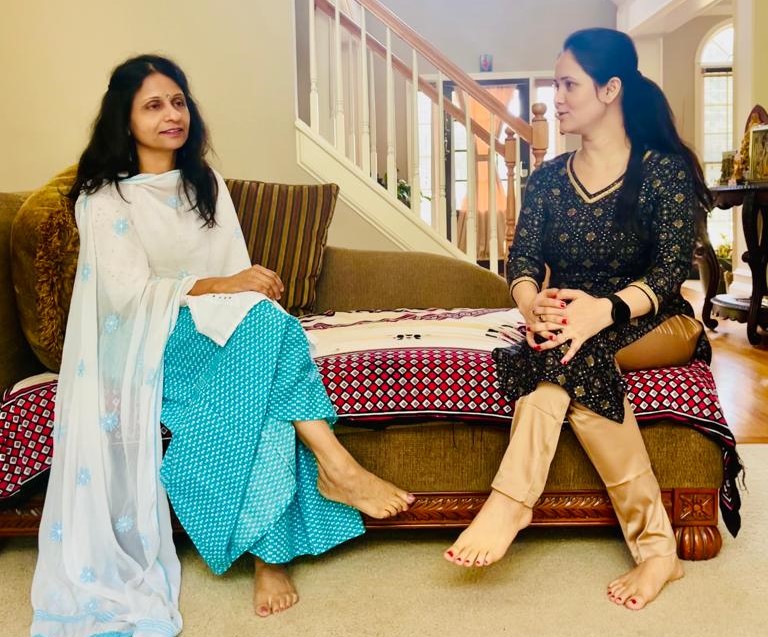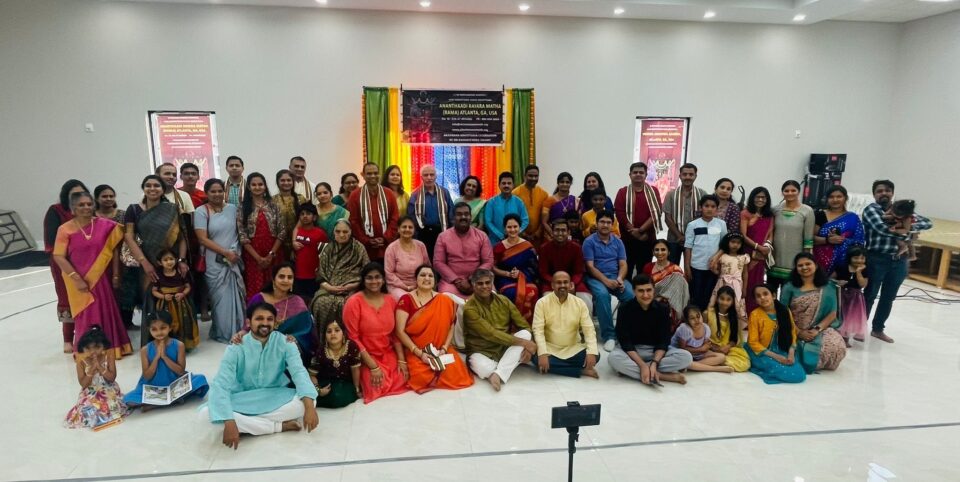BY JYOTHSNA HEGDE
Atlanta, GA, June 30, 2023: “Rice, given to a South Indian, becomes, idli – dosa, to a North Indian it becomes biryani, to a Japanese national, it becomes sushi. The ingredient is the same, but the culture, and traditions of the place shape it differently. Ragas are the same,” Vidushi Nandini Rao Gujar said in her exclusive with NRI Pulse, explaining that each raga, while fundamentally the same, is rendered as per the genre, and the place it originated from.
Vidushi Nandini Rao Gujar’s euphonious renditions of Dasa compositions invoked devotion amongst all, at the Dasa Namana concert organized by Ananthaadi Rayara Matha (RAMA) on May 7, 2023 at the Gadhpurdham Swamy Narayan Temple in Atlanta. Rao was brilliantly accompanied by the talented Santosh Chandru on the Mridangam and Nivik Sanjay Bharadwaj on the Violin.

Kicking off the traditional Ganapthi sequence, a Purandaradasaru composition, Gujar embarked on a musical journey that doused the audience in celestial melody. Amongst the highlights of the concert was Gujar’s introduction of the well-known “Dasana madiko enna” in various taalas including Mishra, Chaturashra, Khanda and others. The change of pace and rhythm of the very popular song captivated the listeners. Rao also explained that Dasa compositions have been presented in different forms of music including Hindustani, Carnatic, and light music, so that people can enjoy the music and lyrics depending on the kind of music that appeals most to them.
Gujar’s presentation of Sundarakanda showcased the artist’s inherent talent, her love and dedication for music and a child-like enthusiasm in elaborating the background of the songs and rendering them to perfection. Some of the other Dasa compositions that enthralled the audience included Swagatham Krishna, Jagadodharana, Himagiri Thanaye, and Yamanelli Kaananendu.

Haridasas (“servants of Lord Hari”) were preachers of bhakti to Lord Vishnu or one of his avatars. The bhakti literature of these Haridasas is collectively referred to as Dasa Sahitya. It is in the Kannada language. Haridasa movement traces its origin to the Dwaitha philosophy of Madhwacharya (1238-1317). Dasas are Dwaitha scholars and poets. Over a span of nearly six centuries, between the thirteen century and fourteenth century C.E., Haridasa saints and mystics impacted the culture, philosophy, music, and art of Karnataka and the rest of South India. The main compositions of the Haridasas are in the form of kirtanas (padas or devaranamas.), songs, ugabhogas, non-metrical short pieces, and suladis, compositions set to seven different talas, traditional metrical patterns. These compositions give precedence to sentiment over melody.
Gujar’s work as a Carnatic classical vocalist and performances have been recognized throughout the country. For over two decades, Nandini Rao Gujar has been pursuing her research in different styles of devotional music not just from the south but from all over India. Television, live performances, Masters in Music, anchoring, accompanying dance performances, composing song writing, teaching are various ways in which Gujar finds herself associated with music. She is the recipient of the prestigious Kempegowda Award, conferred by the Government of Karnataka.
Since her maiden solo concert at the age of 12, Nandini has given more than 900 concerts all over India and abroad. She has given her voice to over 100 Audio CDs.
Gujar is a Professor at FLAME School of Performing Arts and is also a guest faculty at Pune University. Nandini is the founder of ‘Sound of Southern India’, an Institute of Carnatic Classical Music in Pune, in which many students are trained in classical and other aspects of Carnatic music. Gujar is a vocal support artist for many dance productions and Arangetrams for prominent Bharatanatyam Gurus including Sucheta Chapekar, Smitha Mahajan, Parimal Phadke and Priya Joshi, Smt. Ranjani & Gayatri, Chennai Vid Prof Nagamani Srinath, Bangalore, and B R Sridhar, Bhadravathi Late Prasanna Venkatesh, Shimoga, among others.

What is it about Dasa compositions that is so special?
“In classical music, you don’t have any boundaries,” Gujar noted. Explaining that initially when she performed in Telugu, Tamil and Sanskrit, she understood the languages, but somehow felt was not able to convey that to her audience in the way that it was meant to. Dasa Sahitya/compositions, Gujar feels gaps that bridge. Dasa compositions are simplistic in nature and easy for a common man to relate and understand. As a singer when she could sing these compositions having fully grasped the nuances, Gujar feels the same is conveyed to the listener and the audience relates to Dasa compositions better because of it.
“Every concert experience is different. Even when you practice every day, the experience is different. I sing different genres of music and in different languages. But I think Krishna songs, is what I’ve always realized gives me real happiness,” Gujar said about her favorite pick.
While a houseful audience brings her joy like no other, Gujar admits that few simple concerts, such as the one she used to sing for a family gathering during Navaratri when the lady of the house was alive, brought her special gratification.
What is her take on the current trend of online music classes for students?
Gujar opines that, especially for younger kids, initial teaching serves best in person. But classes in later stages can be converted to online.
“Collaborations (between various genres of musicians) are very good because, apart from not restricting ourselves to our own style, we have the chance to explore other types of music and that is now new ragas are formed,” Gujar said. Gujar recently came up with a concept where Hindustani, Carnatic, and Drupad, one of the oldest forms of classical music singers present the same composition in all three styles. The concept was recorded ahead of her US trip.
As an invitee at Istanbul University, Gujar collaborated with Turkish musicians to uncover the potential of ragas. Gujar said the project zoomed in on Raga Mayamalaavagoula, an initial raga that kids learn early on. “They have the same hijas (ragas).. In fact, if you carefully listen to their morning Namaz, the raga would be Mayamaalavagoula with a few additional notes,” Gujar noted. Gujar said she worked with Turkish musicians on a documentary with their instruments on the Karuniso Ranga, a popular song associated with the maestro Bhimsen Joshi.
RAMA is a registered religious non-profit organization dedicated to establishing a matha in Atlanta area with the aim to continue religious activities as per Madhwa principles(tatva) along with emphasizing the learning & training (RAMA Gurukula) and keeping up the traditions, preachings of great Madhwa philosophers (yatis, haridasas, and acharyas). In that path, we had a great opportunity to felicitate Vidushi Smt. Nandini Rao a great very well-known Haridasa singer from India along with local talented artists -Shri Santosh Chandru and Chi. Nivik Bharadhwaj. This event was organized by the RAMA’s dedicated volunteers and donors. It was a very successful event. Attendees enjoyed the melodious Hari keertanas for the good 2 and half hours. RAMA is inspired by this event’s success to organize many more such events soon. Currently, RAMA is geared up in finalizing Summer Virtual Camp – Jul-Aug, Rayara Aradhane – Aug-Sep (30, 31st Aug – 1st Sep) and Dasara Aaradhane – Nov-Dec.” Pradeep Vittalamurthy, Founder, RAMA, said.





